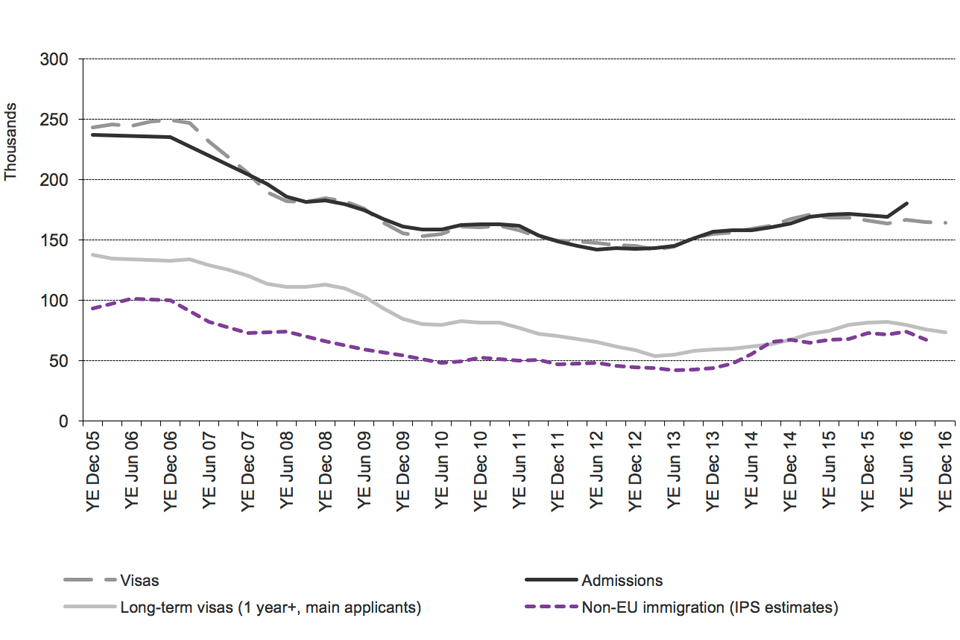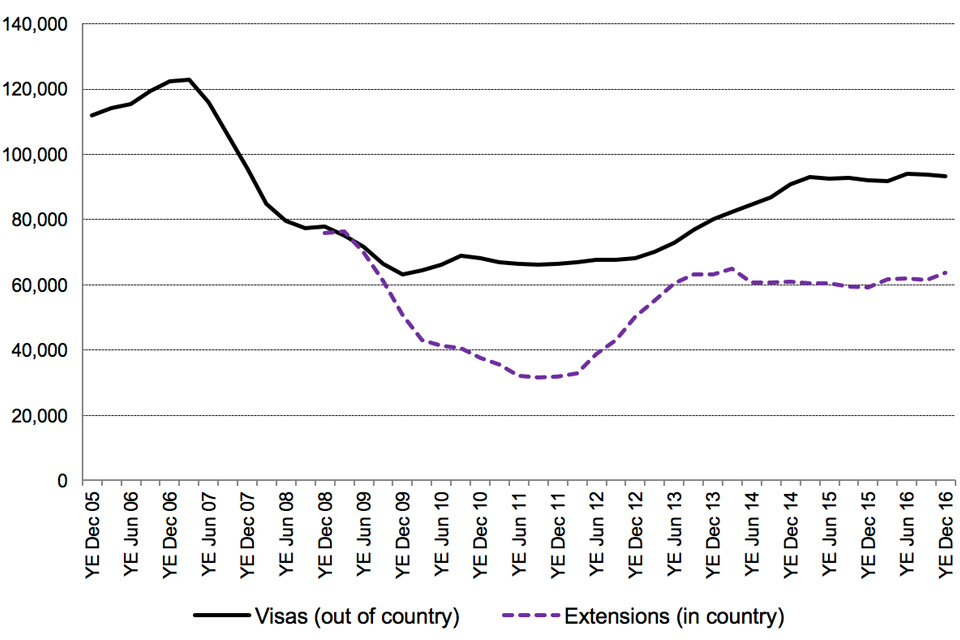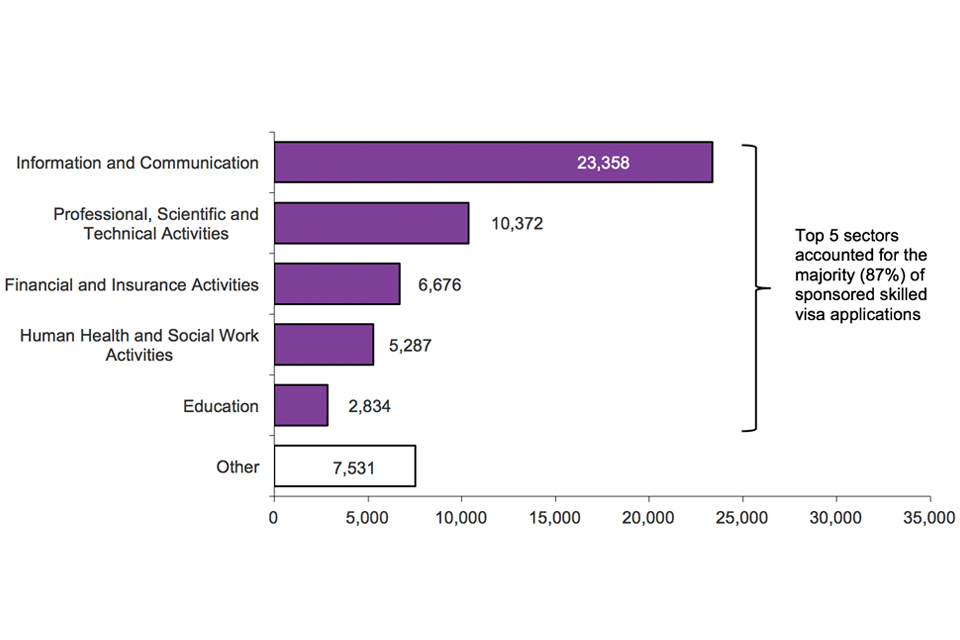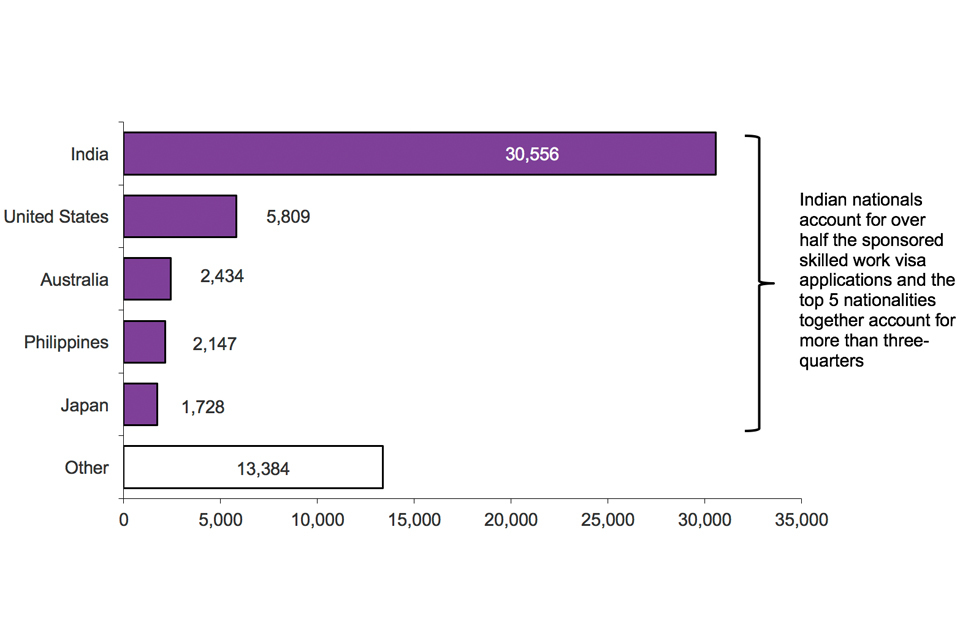Work
Published 23 February 2017
Valid: 23 February 2017 to 24 May 2017
Data relate to the calendar year 2016 and all comparisons are with the calendar year 2015, unless indicated otherwise.
Back to Immigration statistics October to December 2016 content page.
This is not the latest release. View latest release.
1. Key facts
There were 56,058 Tier 2 Skilled work-sponsored visa applications in 2016 (non-European Economic Area (EEA) main applicants, Certificates of Sponsorship (CoS) used), similar to the level in 2015 (56,012). This included a 49% increase (1,748 more visas) in the Human health and social work activities sector, which is largely likely to reflect the addition of nurses to the government’s shortage occupation list in November 2015. There were small falls in applications from most other sectors including the Information and communication sector (down 557; 2%) and Professional, scientific and technical activities (down 685; 6%).
Including dependants, there were 93,244 Tier 2 Skilled work visas granted in 2016, 1% higher than the previous year (92,026), and 42,033 Tier 5 Youth mobility and temporary visas granted, down 2,895 (6%). Just 2,564 Tier 2 Skilled work visas were refused (3% of Tier 2 decisions).
Indian nationals accounted for 53,575 (57%) of Skilled work visas granted in 2016, with USA nationals the next largest group (9,348 or 10% of the total).
There were also 33,484 Tier 2 Skilled work-sponsored applications for extensions in 2016 (main applicants, CoS used), up 7% from 2015 (31,270). This included increases for most sectors, including Education (+799; 20%), Professional, scientific and technical activities (up 602 or 11%), and Information and communication (+539; 9%), and a fall of nearly a half for Accommodation and food service activities (down 577 or 48%). Grants of Tier 2 Skilled work extensions rose 6% (from 33,185 to 35,036).
There were 849 (16%) fewer Tier 1 Unsponsored work visas granted in 2016, which continues to reflect the impact of the closure of the Tier 1 General category to new applicants (down 847; 74%). There also continues to be fewer Exceptional talent visas granted (306 in 2016) than the annual number of places available (1,000 each year).
In the year ending September 2016, the Office for National Statistics (ONS) estimates there were 67,000 non-European Union (EU) long-term immigrants for work, similar to the previous 12 months (the difference was not statistically significant).
2. Work immigration: latest trends
| 2015 | 2016 | Change | Percentage change | |
|---|---|---|---|---|
| Work-related visas issued | 165,900 | 163,882 | -2,018 | -1% |
| of which: | ||||
| High-value (Tier 1) visas | 5,389 | 4,540 | -849 | -16% |
| Skilled (Tier 2) visas | 92,026 | 93,244 | +1,218 | +1% |
| Youth mobility and temporary workers (Tier 5) visas | 44,928 | 42,033 | -2,895 | -6% |
| Non-PBS/Other work visas | 23,557 | 24,065 | +508 | +2% |
| Year ending September 2015 | Year ending September 2016 | Change | Percentage change | |
| ONS estimate of non-EU long-term immigration for work (1), excluding dependants | 68,000 | 67,000 | -1,000 | -1% |
| Long-term (1 year or more) work-related visas, excluding dependants | 79,390 | 75,718 | -3,672 | -5% |
2.1 Table notes
Source: Home Office, Immigration Statistics October to December 2016, Visas table vi 04_q (Visas volume 1), International Passenger Survey (IPS), ONS Migration Statistics Quarterly Report.
(1) Immigration for work data are estimates of the number of non-EU nationals intending to change their residence to the UK for at least 12 months based on the IPS.
3. Long-term trends in work-related immigration
There was a long-term reduction in work-related visas granted, admissions, and non-EU immigration from 2006 to 2012. Since 2013, increases have been seen in all groups, with some fluctuations. There have been falls in extensions related to the previous closure of the Tier 1 General and Tier 1 Post-study categories to new applicants (see below).
The chart below shows that work-related visas and admissions have been moving in line with each other over the long term. IPS estimates of non-EU work immigration are substantially lower as these include only those migrants who state they intend to remain in the UK for a year or more. However, the two series show broadly similar trends with falls from 2006 followed by increases from the middle of 2013 and relative stability over the latest year.
3.1 Long-term trends in work-related immigration

The chart shows the trends for Work visas granted, admissions, and IPS estimates of non-EU immigration between 2005 and the latest data published. The data are sourced from Visas table vi 04 q and Admissions table ad 02 q, and corresponding datasets.
Chart notes
Source: Home Office, Immigration Statistics October to December 2016, Visas table vi 04 q (Visas volume 1), Admissions table ad 02 q and corresponding datasets; ONS, ‘Population and migration’.
There are a range of potential reasons why IPS figures differ from figures for Work visas granted or passenger arrivals, and hence why the trends in the different series do not always correspond, including:
- IPS estimates only include those people arriving with an intention to remain for 12 months or more, whereas visa data will include any visa length
- sampling variation in the IPS (for example the fall of 1,000 in non-EU work-related immigration for the year ending September 2016 has an estimated confidence interval of +/-14,000)
- IPS data for work relating to individuals whose main reason for migration was work related so (unlike visas data) are likely to exclude their dependants; IPS data are more comparable with visa totals for main applicants than with total visas which include dependents of holders of a Work visa
- differences between intentions and visa length
- individuals may migrate for multiple different reasons
- timing differences between when visas are granted and when an individual actually travels
Further comparisons of the data are described in the user guide.
3.2 Skilled work visas and extensions granted, 2005 to 2016, including dependants

The chart shows the trends for Skilled work visas and extensions granted between 2008 and the latest data published. The data are sourced from Visas table vi 01 q and Admissions table ex 01 q.
Chart notes
Source: Home Office, Immigration Statistics October to December 2016, Visas table vi 01 q (Visas volume 1), Extensions table ex 01 q.
4. Further analysis: Skilled work (Tier 2)
4.1 Sponsored visa applications, by nationality and industry sector
The number of sponsored visa applications for Skilled work was 56,058 in 2016 (main applicants, CoS used), similar to 2015 (56,012). The largest change was in the Human health and social work activities sector, an increase of 1,748 (49%), which is largely likely to reflect the addition of nurses to the government’s shortage occupation list in November 2015.
There were 23,358 applications from the Information and communication sector in 2016, and this sector alone accounted for 42% of all Skilled work-sponsored visa applications. Applications from this sector have decreased in 2016 (by 557 or 2%) for the first time in 5 years.
4.2 Sponsored visa applications by industry sector, 2016

The chart shows the sponsored visa applications by industry sector for 2016. The data are sourced from the Sponsorship tables. The top 5 sectors accounted for the large majority (87%) of sponsored Skilled work visa applications.
Chart notes
Source: Home Office, Immigration Statistics October to December 2016, Sponsorship tables.
Indian nationals accounted for over half (55% or 30,556) of the 56,058 applications.
4.3 Sponsored Skilled work visa applications, by nationality, 2016

The chart shows the sponsored visa applications by nationality for 2016. The data are sourced from the Sponsorship tables.
Chart notes
Source: Home Office, Immigration Statistics October to December 2016, Sponsorship tables.
5. Skilled work visas and extensions granted
In 2016, almost all (97%) of the 95,992 decisions made on entry clearance applications for Skilled work were grants (93,244). The rise in Skilled (Tier 2) grants was mainly accounted for by an increase of 961 (6%) in Tier 2 General main applicants.
5.1 Skilled work: latest trends in visa grants
| 2015 | 2016 | Change | Percentage change | |
|---|---|---|---|---|
| Skilled (Tier 2) visas granted | 92,026 | 93,244 | +1,218 | +1% |
| of which: | ||||
| Main applicants | 54,365 | 54,841 | +476 | +1% |
| of which | ||||
| Tier 2: General | 17,366 | 18,327 | +961 | +6% |
| Tier 2: Intra-company transfers | 2,182 | 2,001 | -181 | -8% |
| Tier 2: Intra-company transfers short term | 21,224 | 20,739 | -485 | -2% |
| Tier 2: Intra-company transfers long term | 13,006 | 13,280 | +274 | +2% |
| Tier 2: Ministers of religion | 411 | 342 | -69 | -17% |
| Tier 2: Sportsperson | 125 | 108 | -17 | -14% |
| Work Permit holders | 51 | 44 | -7 | -14% |
| Dependants | 37,661 | 38,403 | +742 | +2% |
| of which | ||||
| Tier 2: Dependant | 15,141 | 14,244 | -897 | -6% |
| Tier 2: Intra-company transfers short term | 8,406 | 9,006 | +600 | +7% |
| Tier 2 – Intra-company transfers long term | 14,093 | 15,135 | +1,042 | +7% |
| Work Permit holders | 21 | 18 | -3 | -14% |
Table notes
Source: Home Office, Immigration Statistics October to December 2016, Visas table vi 04 q (Visas volume 1).
Similarly, in 2016, almost all (96%) of the 66,372 decisions on extensions of stay for Skilled work were grants (63,578). There was a 7% increase (+4,359) in extensions granted, which was accounted for by an increase of 4,058 in extensions for the Tier 2 General category (for both main applicants and their dependents combined).
5.2 Skilled work: latest trends in grants of extensions
| 2015 | 2016 | Change | Percentage change | |
|---|---|---|---|---|
| Skilled (Tier 2) granted of extensions | 59,219 | 63,578 | +4,359 | +7% |
| of which: | ||||
| Main applicants | 33,185 | 35,036 | +1,851 | +6% |
| of which | ||||
| Tier 2: General | 24,446 | 26,162 | +1,716 | +7% |
| Tier 2: Intra-company transfers | 8,237 | 8,324 | +87 | +1% |
| Tier 2: Ministers of religion | 410 | 444 | +34 | +8% |
| Tier 2: Sportsperson | 91 | 106 | +15 | +16% |
| Work Permit holders | 1 | 0 | -1 | -100% |
| Dependants | 26,034 | 28,542 | +2,508 | +10% |
| of which | ||||
| Tier 2: General | 15,739 | 18,081 | +2,342 | +15% |
| Tier 2: Intra-company transfers | 9,775 | 9,853 | +78 | +1% |
| Tier 2: Ministers of religion | 447 | 512 | +65 | +15% |
| Tier 2: Sportsperson | 65 | 93 | +28 | +43% |
| Work Permit holders | 8 | 3 | -5 | -63% |
Table notes
Source: Home Office, Immigration Statistics October to December 2016, Extensions table ex 01 q.
5.3 Extensions granted in Tier 2 by previous category
Looking at each individual’s previous category in the latest available statistics for 2015, there were 33,184 extensions granted for Skilled work. Of these, it is estimated that 26,185 were extensions of leave for individuals already in Tier 2 (i.e. Skilled work), while 6,004 were grants for Skilled work to former students, and 331 were grants to individuals previously in the Tier 1 Post-study category (now closed to new entrants). An update of this analysis is planned to be published in May 2017.
6. Staying in the UK
In February 2017 the Home Office published ‘Statistics on changes in migrants’ visa and leave status: 2015’, which shows how non-EEA migrants change their immigration status or achieve settlement in the UK.
The main points were:
- over a quarter (30%; 21,507) of those issued a Skilled work visa (which has a potential path to settlement) in 2010 had been granted settlement 5 years after their initial visa had been granted; a further 14% (10,255) still had valid leave to remain in the UK
- Indian nationals were the largest foreign nationality amongst skilled workers in 2010 (as now), representing 40% of the total and, of these skilled Indian nationals, 32% had received settlement after 5 years, while a further 12% still had valid leave to remain in the UK
- of the top 5 nationalities issued a Skilled work visa in the 2010 cohort, American and Australian nationals were less likely to have applied for and been granted settlement after 5 years (10% and 14% respectively), whereas Pakistani nationals were more likely to have settled (57% of Pakistani skilled workers had reached settlement by 2015)
Source: Home Office, ‘Statistics on changes in migrants’ visa and leave status: 2015’.
7. UK nationals and non-UK nationals: Employment levels
Estimates from the Labour Force Survey ‘UK Labour Market: February 2017’ published by the ONS, show that the number of UK nationals in employment in October to December 2016 was 28.4 million, an increase of 70,000 (0.2%) compared with the same quarter in 2015. The employment rate for UK nationals in October to December 2016 was 75.0%, up 0.4 percentage points on the previous year. This is the highest rate recorded since the series began in 1997.
There were 3.5 million non-UK nationals in employment in October to December 2016, an increase of 233,000 (7.2%) compared with the same quarter in 2015. The employment rate for non-UK nationals was 73.1%, up 0.9 percentage points on the previous year.
There was an increase in EU nationals in employment (up 190,000 to 2.2 million), with increases in each of the EU14 (up 68,000 to 930,000), EU8 (up 41,000 to 1.0 million) and EU2 (up 82,000 to 286,000) groups. The number of non-EU nationals in employment remained at a similar level of 1.2 million.
The total growth in employment over the last year was 299,000. This increase was accounted for primarily by EU nationals (63%) and UK nationals (23%), with non-EU nationals responsible for the remaining 14%.
8. Data tables
Data on immigration for work, sourced from Home Office administrative systems, can be found in the following tables:
Visas vol. 1: tables vi 01 q, vi 04 and vi 04 q
vi 01 q Entry clearance visa applications and resolution by category
vi 04 Entry clearance visas granted by category
vi 04 q Entry clearance visas granted by category
Visas vol. 2: table vi 06 q w
vi 06 q w Entry clearance visas granted by category and country of nationality: Work
Sponsorship: tables cs 01 q to cs 06 q
Admissions: tables ad 02 to ad 03 and ad 03 w
Extensions: tables ex 01 to ex 02, ex 02 w and expc 01 w
Settlement: tables se 01 to se 03
European Economic Area (EEA): tables ee 01, ee 01 q and ee 02
9. Background information
This section includes figures on work-related visas granted, passenger arrivals and extensions granted for non-EEA nationals. It also includes figures on long-term immigration to work (i.e. those intending to stay for at least 12 months for work) for non-EU nationals.
Data include dependants as well as main applicants unless stated otherwise. Provisional estimates of long-term immigration for work from the ONS IPS relate to those whose main reason for migration is to work and so are likely to exclude dependants (who would be more likely to say their main reason was to ‘accompany or join’ rather than to work).
9.1 Reason for migration and the labour market
IPS statistics and visa statistics represent flows of people, only a proportion of whom will remain for longer periods. A recent Home Office research report, ‘The reason for migration and labour market characteristics of UK residents born abroad’ (September 2014), uses ONS data from the Labour Force Survey to provide estimates of the number of residents born abroad by the reason for original migration.
A key finding of this was that the distribution of original purposes given for migration by people resident in the UK who were born abroad is different from that produced when looking at the migration flows reported in the IPS. For example, the proportion of people who come for family purposes or as a dependant takes greater significance, because of the higher likelihood of people who come for relationship reasons to stay longer. Similarly, although many foreign students are temporary, the analysis confirmed findings in other studies that a number of foreign students do stay on as residents.
9.2 Tier 1 (Exceptional Talent) limit
Tier 1 Exceptional Talent, introduced in August 2011, is for applicants already internationally recognised at the highest level in their particular field or who have demonstrated exceptional promise and are likely to become future leaders in their field. Applicants must hold an endorsement from one of five recognised bodies: Royal Society, British Academy, Royal Academy of Engineering, Arts Council England, and, since April 2014, Tech City UK. The annual limit for the Exceptional Talent category is 1,000 visas per year, with 500 places released in April and another 500 in October. There were 319 decisions and 306 grants of Tier 1 Exceptional Talent entry clearance visas (main applicants) in 2016, representing 31% of the annual limit.
